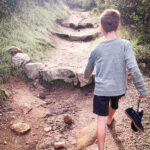What is a homeschool style?
Homeschool style refers to the approach a family takes to their home education. There are several common styles, and a whole bunch of new ones popping up as families continue to seek out new ways to learn and live.
Without going into an exhaustive list, you might recognize some of the more common styles, like Classical, Charlotte Mason, Unschool, Montessori, Eclectic, Unit Studies, etc. Then there are other coined terms for styles like Adventureschool, Wildschool, Lifeschool, Natureschool, Deschooling, Minimalist Homeschool, Roadschool, and so many more. Each one has its own unique take on how to raise up a child, just as each family’s approach to parenting will vary.
Why Choose a Style?
Many families like to choose a homeschool style because it gives them direction and community. They can connect with other like-minded homeschoolers, join co-ops that support their preferences, and find curriculum that aligns with their beliefs.
Choosing a homeschool style can be a great way to get started on your homeschool journey. For example, one question I am asked quite often is about what curriculum we use. But over the years our curriculum (or lack there of) has changed. And what is right for our family, might not be right for your family. Plus, with entire thick catalogs of curriculum to choose from, plus all of the beautiful curriculum created by homeschoolers that is for sale online, the thousands of choices can make us freeze in confusion. How is one to choose with so much available?
Finding Your Style
Identifying with a style can save you a lot of time, confusion and frustration when it comes to choosing curriculum. Knowing what style (or multiple styles) you feel most fits your desires for your home education can eliminate the majority of curriculum on the market and point you in a general starting direction. However, keep in mind that finding your style doesn’t have to be a forever commitment, and it most certainly does NOT have to define your homeschool – it is simply a tool. A starting point.
To find your style, head to your favourite search engine and type in “homeschool style quiz”. Take any quiz that pops up, and it should help you rank which of the most common styles fit within your preferences. Once you have that style, start researching curriculum, local meet ups, co-ops, etc. that follow that same method. BUT! And this is a huge but… remember, that you do not have to identify as that style. This is simply a place to start. Of course you might find that you’re a Classical purist, or you adore absolutely everything about the Charlotte Mason method and want to follow it to the letter… but the many families tend to grab pieces from many different styles of learning. Plus, what works for one child may not work for another child, and you might want to change it up from year to year, depending on what you end up liking or not liking. Don’t be afraid to change! That’s the beauty of homeschool – if something isn’t working, try something else.
Do You Need a Homeschool Style?
The short answer is, no, you do not need a homeschool style. In fact we started our homeschool journey having not heard of homeschool styles for probably the first three years of our journey.
When I finally learned about homeschool styles, however, it came as a relief to me. I was able to narrow it down to two styles (which funny enough are complete opposites). What we’ve since grown, and what continues to evolve, is our own completely unique approach to home education. I have no word for what style it is – it’s just ours. But identifying our top two styles put me on a path to discovering what would end up working best for our family. It allowed me to research within a certain mindset and find other people who are similar.
So do you need a homeschool style? No. Should you have one? Perhaps, but that’s a personal choice. Should you take the quiz? Yes. Especially if you’re new or trying to figure out where to go next. It just might illuminate the best direction for your homeschool.
Related Posts














